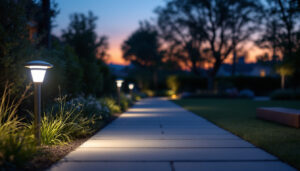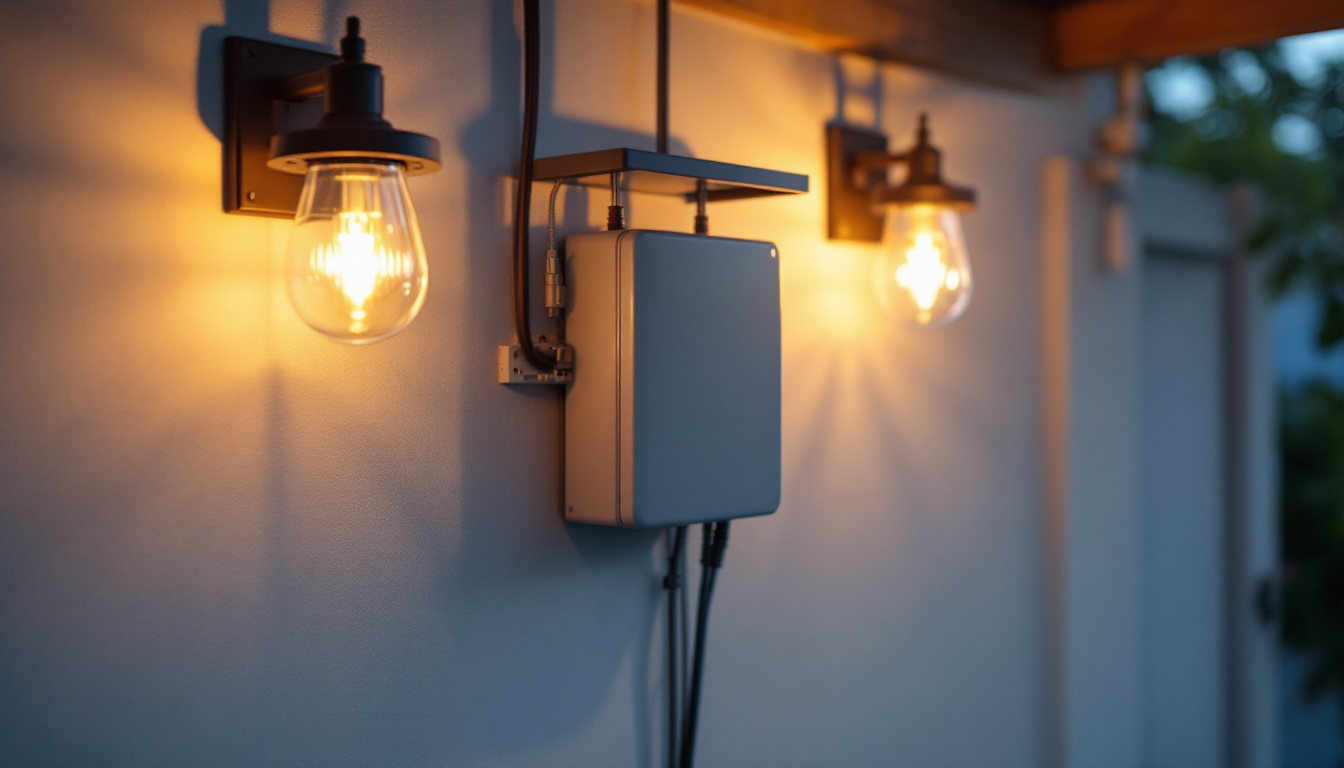

In the ever-evolving world of lighting technology, motion detectors have emerged as a game-changer for both residential and commercial applications. For lighting contractors, understanding the intricacies of motion detectors is essential for providing clients with energy-efficient, convenient, and secure lighting solutions. This comprehensive guide delves into the various aspects of motion detectors, from their functionality to installation tips, ensuring that lighting contractors are well-equipped to meet the demands of their clients.
Motion detectors are devices designed to detect movement within a specific area. They are commonly used to control lighting, turning lights on or off based on the presence of individuals. This technology not only enhances convenience but also contributes significantly to energy savings by ensuring that lights are only active when needed. With the rise of smart home technology, motion detectors can now be integrated into broader home automation systems, allowing for seamless control over lighting and security features through mobile apps or voice commands.
These devices typically use various sensing technologies, including passive infrared (PIR), ultrasonic, and dual-technology sensors. Each type has its unique advantages and applications, making it crucial for contractors to understand their differences to recommend the most suitable option for their clients. For instance, while PIR sensors are generally more cost-effective and widely used, ultrasonic sensors may be preferred in environments where precise detection is necessary, such as in art galleries or museums where movement needs to be monitored without disturbing the ambiance.
When it comes to motion detectors, there are three primary types that contractors should be familiar with:
Motion detectors can be used in a variety of settings, making them versatile tools for lighting contractors. Common applications include:
Furthermore, the integration of motion detectors with smart technology has opened up new possibilities for automation. For example, in smart homes, motion detectors can trigger not only lighting but also heating or cooling systems, ensuring that energy is used efficiently. This interconnectedness enhances user experience and provides a higher level of control over the home environment. As technology continues to evolve, the potential applications for motion detectors will likely expand, making them an essential component in modern building design and energy management strategies.
One of the most compelling reasons to incorporate motion detectors into lighting systems is their energy efficiency. By ensuring that lights are only activated when necessary, these devices can significantly reduce electricity consumption. This not only lowers utility bills for clients but also contributes to a more sustainable environment.
In commercial settings, energy savings can be particularly substantial. Businesses often face high energy costs, and implementing motion detectors can lead to significant reductions, making them an attractive option for cost-conscious clients.
Motion detectors play a vital role in enhancing security for both residential and commercial properties. By automatically illuminating areas when movement is detected, these devices deter potential intruders and provide peace of mind for property owners.
In outdoor applications, motion-activated lights can illuminate pathways, driveways, and entry points, making it safer for residents and visitors. In commercial settings, they can help ensure that dark areas are well-lit, reducing the risk of accidents and unauthorized access.
For many clients, convenience is a primary reason for opting for motion detectors. These devices allow for hands-free operation, making it easier for individuals to navigate spaces without fumbling for light switches. This is particularly beneficial in areas such as garages, basements, and outdoor spaces where hands may be full or visibility is limited.
Moreover, motion detectors can be configured to work in conjunction with smart home systems, allowing for integration with other automated features. This level of convenience appeals to tech-savvy clients looking for modern solutions.
Before installation, a thorough site assessment is essential. Contractors should evaluate the area where the motion detector will be installed, considering factors such as the layout, potential obstructions, and the specific needs of the client.
Identifying high-traffic areas and potential blind spots can help determine the optimal placement of motion detectors. This assessment ensures that the devices will function effectively and provide the desired coverage.
Motion detectors can be powered in several ways, including battery-operated, hardwired, or solar-powered options. Contractors should discuss these options with clients to determine the most suitable choice based on the specific application and location.
For hardwired installations, ensuring that the wiring is properly concealed and protected is crucial for both aesthetics and safety. Proper installation techniques can help prevent future maintenance issues and ensure longevity.
Once installed, motion detectors require calibration to ensure optimal performance. This process involves adjusting sensitivity settings, detection range, and time delay settings to meet the specific needs of the environment.
Testing the system after installation is vital to confirm that it operates as intended. Contractors should encourage clients to provide feedback during this phase to make any necessary adjustments before finalizing the installation.
One of the most common issues faced with motion detectors is false triggering. This can occur due to various factors, such as pets, passing vehicles, or environmental conditions like wind or rain. To mitigate this, contractors should recommend the appropriate type of sensor based on the installation environment.
Additionally, adjusting the sensitivity settings and positioning the detector away from potential sources of interference can help reduce false alarms. Educating clients on the importance of proper placement and settings is key to minimizing this challenge.
Another challenge that may arise is limited detection range, which can lead to areas being left unlit. Contractors should ensure that the selected motion detector has an adequate range for the specific application.
In cases where larger areas need coverage, utilizing multiple detectors or opting for dual-technology sensors can enhance overall effectiveness. Properly assessing the site and recommending the right products can help avoid this issue.
Environmental factors such as temperature fluctuations, humidity, and dust can affect the performance of motion detectors. Contractors should advise clients on maintaining the devices to ensure optimal functionality.
Regular cleaning and inspections can help prevent issues related to environmental exposure. Additionally, selecting sensors designed for specific environmental conditions can enhance reliability and performance.
As smart home technology continues to gain popularity, integrating motion detectors into these systems offers numerous benefits. Contractors should be familiar with various smart home platforms to provide clients with seamless integration options.
Motion detectors can be connected to smart lighting systems, allowing for remote control and automation. Clients can program their lights to turn on or off based on their schedules or when they are away from home, enhancing both convenience and security.
For commercial clients, integrating motion detectors with energy management systems can lead to significant savings. These systems can monitor energy usage and adjust lighting based on occupancy, ensuring that lights are only active when necessary.
Contractors should be prepared to discuss the benefits of these integrations with clients, highlighting how they can lead to improved energy efficiency and reduced operational costs.
The field of motion detection technology is continuously evolving, with advancements in artificial intelligence and machine learning paving the way for smarter solutions. Contractors should stay informed about emerging trends to provide clients with cutting-edge options.
Future developments may include enhanced detection capabilities, improved energy efficiency, and greater integration with other smart devices. Keeping abreast of these trends will enable contractors to offer innovative solutions that meet the changing needs of their clients.
Motion detectors are an invaluable tool for lighting contractors, offering a range of benefits including energy efficiency, enhanced security, and convenience. By understanding the various types of motion detectors, their applications, and installation considerations, contractors can provide clients with tailored solutions that meet their specific needs.
By addressing common challenges and integrating motion detectors with smart technology, contractors can stay ahead in the competitive lighting industry. As technology continues to advance, staying informed about the latest trends will ensure that lighting contractors remain a trusted resource for their clients.
In summary, the effective use of motion detectors not only enhances the functionality of lighting systems but also contributes to a more sustainable and secure environment. As the demand for energy-efficient and smart solutions grows, lighting contractors must be prepared to embrace these innovations and deliver exceptional service to their clients.
Ready to elevate your lighting projects with the latest in motion detector technology? Look no further than LumenWholesale for a comprehensive selection of spec-grade lighting products. Our commitment to quality and affordability ensures you receive the best value on the market. Say goodbye to middleman markups and hello to hassle-free bulk buying with free shipping. Don’t compromise on performance or price. Visit LumenWholesale today and discover the perfect blend of quality, affordability, and convenience for all your lighting needs.

Discover the pitfalls of purchasing smart home automation products in bulk from local distributors.

Explore the essential insights lighting contractors need with “Brightest Bulb: Demystified.” Uncover the latest innovations, industry standards, and expert tips to illuminate your projects with precision and efficiency..

Discover the transformative power of 5000K light in enhancing lighting installation projects.

Discover the essential answers to lighting contractors’ most common questions about electrical boxes outside.
Get notified when NEW deals are released.
Optimize your budget with wholesale discounts.
Only top-quality, specification-grade lighting products.
No additional costs at checkout - what you see is what you pay.
We understand the unique needs of contractors.